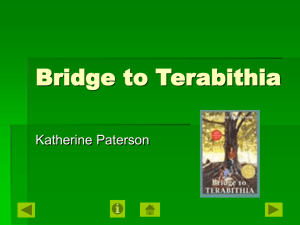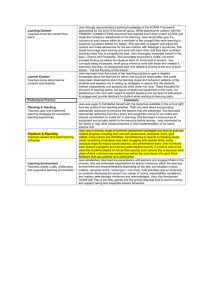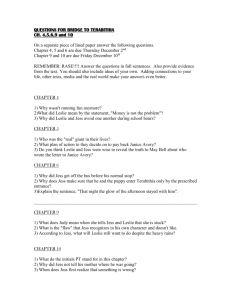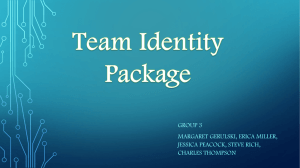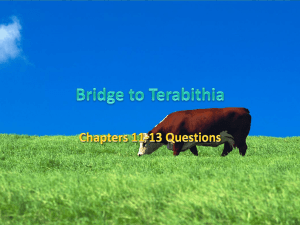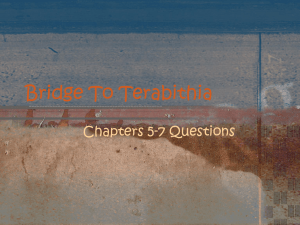Adaptive Learning Environments
advertisement
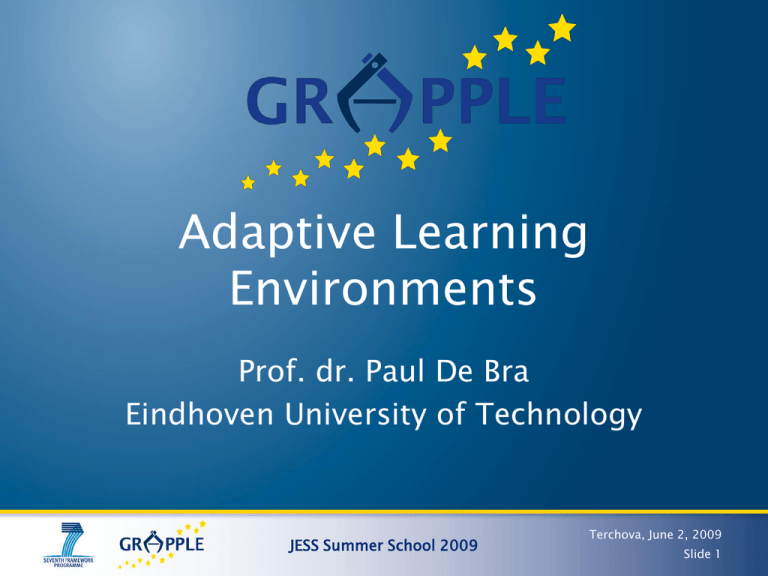
Adaptive Learning
Environments
Prof. dr. Paul De Bra
Eindhoven University of Technology
JESS Summer School 2009
Terchova, June 2, 2009
Slide 1
Topics
• The need for adaptation
– personalized: adaptable / adaptive
• User Modeling
• Adaptation
– adaptive presentation
– adaptive navigation
• The GRAPPLE architecture
• Authoring
• Examples (if we have time)
JESS Summer School 2009
Terchova, June 2, 2009
Slide 2
We live in a “one size fits all” world
But we are not all the same size
(physically or mentally)
JESS Summer School 2009
Terchova, June 2, 2009
Slide 3
What’s the main difference
between these pictures?
JESS Summer School 2009
Terchova, June 2, 2009
Slide 4
Automatic Adaptive
• Automatic systems = automatic fixed behavior
(according to fixed rules)
• Adaptive systems = automatic behavior that
depends on environmental factors
– first-order adaptation: the change in the
automatic behavior follows fixed rules
– second-order adaptation: the change in the
automatic behavior is itself also adaptive
– etc.: there is no limit to how adaptive systems
can be
• In this lecture we deal with user-adaptive systems:
they adapt to users and the users’ environment
JESS Summer School 2009
Terchova, June 2, 2009
Slide 5
Adaptation in any type of
Information System
• Adaptation of the Information
– information adapted to who/where/when you
are
– information adapted to what you are doing and
what you have done before (e.g. learning)
– presentation adapted to circumstances (e.g. the
device you use, the network, etc.)
• Adaptation of the Process
– adaptation of interaction and/or dialog
– adaptation of navigation structures
– adaptation of the order of tasks and steps
JESS Summer School 2009
Terchova, June 2, 2009
Slide 6
Advantages of Adaptive Systems
• Increased efficiency:
– optimal process (of navigation, dialog, study order, etc.)
– minimum number of steps
– maximum benefit (of relevant information)
• Increased satisfaction:
– system gives good advice and relevant information
– interactive applications do not make stupid moves
• Return on investment:
– recommending products the user needs is a form of
advertising that really works
– adaptive (non-IS) systems have better technical
performance
JESS Summer School 2009
Terchova, June 2, 2009
Slide 7
Disadvantages of Adaptive Systems
• Adaptive Systems may learn the wrong behavior
– adaptive games learn badly from bad players
– generally: adaptation good for one user may be bad for
another user; it is personal after all
• Adaptive Systems may outsmart the users
– all doomsday movies in which machines take over the
world
blame second order adaptive systems
– a game that learns how always to win is no fun
– an adaptive information system may effectively perform
censorship
– it may be hard to tell an adaptive system that it is wrong
JESS Summer School 2009
Terchova, June 2, 2009
Slide 8
User-Adaptive Systems
JESS Summer School 2009
Terchova, June 2, 2009
Slide 9
Main issues in Adaptive Systems
• Questions to ask when designing an adaptive application:
– Why do we want adaptation?
– What can be adapted?
– What can we adapt to?
– How can we collect the right information?
– How can we process/use that information
• Exercise: answer these questions for:
– a presentation (lectures, talks at conferences)
– an on-line textbook
– a newspaper site or an on-line TV-guide
– a (book, cd, computer, etc.) store
– a (computer) help system
JESS Summer School 2009
Terchova, June 2, 2009
Slide 10
Forward and Backward Reasoning
• Two opposite approaches for adaptation:
• forward reasoning:
1.
2.
3.
4.
register events
translated events to user model information
store the user model information
adaptation based directly on user model information
• backward reasoning:
1. register events
2. store rules to deduce user model information from events
3. store rules to deduce adaptation from user model
information
4. performing adaptation requires backward reasoning:
decide which user model information is needed and then
deduce which event information is needed for that.
JESS Summer School 2009
Terchova, June 2, 2009
Slide 11
Application Areas of AS
• Educational hypermedia systems
– on-line course text, with on-line multiple-choice
or other machine- interpretable tests
– we use AEH, AES and ALE as near-synonyms
• On-line information systems
– information “kiosk”, documentation systems,
encyclopedias, etc.
• On-line help systems
– context-sensitive help, (think of “Clippy”)
• Information retrieval and filtering
– adaptive recommender systems
• etc.
JESS Summer School 2009
Terchova, June 2, 2009
Slide 12
Adaptive Educational Hypermedia
• Origin: Intelligent Tutoring Systems
– combination of reading material and tests
– adaptive course sequencing, depending on test
results
• In Adaptive Educational Hypermedia:
– more freedom for the learner: guidance instead
of enforced sequence
– adaptive content of the course material to solve
comprehension problems when pages or
chapters are read out of sequence
– adaptation based on reading as well as tests
JESS Summer School 2009
Terchova, June 2, 2009
Slide 13
Learning Management Systems
• LMSs offer a “personal” learning environment:
– registration for courses
– personalization of the “workspace”
– access to course material
– assignments, tests, group work
– communication tools: messages, discussion
forums, chat
– no built-in adaptive learning functionality
JESS Summer School 2009
Terchova, June 2, 2009
Slide 14
The GRAPPLE Project
• Glues an ALE and LMS together, offering an
adaptive within the LMS
• LMS and ALE talk with each other through a
shared event bus
• User Model data can be exchanged through
the Grapple User Model Framework (GUMF)
• Authoring is done mostly through graphical
interfaces to create a domain model (DM)
and a conceptual adaptation model (CAM)
JESS Summer School 2009
Terchova, June 2, 2009
Slide 15
The GRAPPLE Learner View
Learner
GRAPPLE
User Model
Framework
Learner scenario
LMS
Shibboleth
GRAPPLE Event Bus
Reposito
Repository
ry
Student
Visualizations
Device
Adaptation
GALE –
adaptation
engine
GALE
Repository
JESS Summer School 2009
Terchova, June 2, 2009
Slide 16
The GRAPPLE Author View
GRAPPLE
Authoring
tool (CAM,
DM, CRT
Author
LMS
DM
Repository
GRAPPLE
User Model
Framework
CAM
Repository
GALE –
compiler
GALE
Repository
Content
Repository
JESS Summer School 2009
Content
Repository
Terchova, June 2, 2009
Slide 17
What can we Adapt to?
• Knowledge of the user
– initialization using stereotypes (beginner, intermediate,
expert)
– represented in an overlay model of the concept structure
of the application
– fine grained or coarse grained
– based on browsing and on tests
• Goals, tasks or interest
– mapped onto the applications concept structure
– difficult to determine unless it is preset by the user or a
workflow
system
– goals may change often and more radically than
knowledge
JESS Summer School 2009
Terchova, June 2, 2009
Slide 18
What can we Adapt to? (cont.)
• Background and experience
– background = user’s experience outside the application
– experience = user’s experience with the application’s
hyperspace
• Preferences
– any explicitly entered aspect of the user that can be used
for adaptation
– examples: media preferences, cognitive style, etc.
• Context / environment
– aspects of the user’s environment, like browsing device,
window size, network bandwidth, processing power, etc.
JESS Summer School 2009
Terchova, June 2, 2009
Slide 19
User Modeling
JESS Summer School 2009
Terchova, June 2, 2009
Slide 20
Modeling “Knowledge” in AES
• Moving target: knowledge changes while using the
application
– scalar model: knowledge of whole course
measured on one scale (used e.g. in MetaDoc)
– structural model: domain knowledge divided into
independent fragments; knowledge measured
per fragment
• type of knowledge (declarative vs. procedural)
• level of knowledge (compared to some “ideal”)
– positive (overlay) or negative information
(bug model) can be used
JESS Summer School 2009
Terchova, June 2, 2009
Slide 21
Overlay Modeling of User Knowledge
• Domain of an application modeled through a
structure (set, hierarchy, network) of concepts.
– concepts can be large chunks (like book
chapters)
– concepts can be tiny (like paragraphs or
fragments of text, rules or constraints)
– relationships between concepts may include:
• part-of: defines a hierarchy from large learning
objectives down to small (atomic) items to be learned
• is-a: semantic relationship between concepts
• prerequisite: study this before that
• some systems (e.g. AHA!) allow the definition of
arbitrary relationships
JESS Summer School 2009
Terchova, June 2, 2009
Slide 22
Which types of knowledge values?
• Early systems: Boolean value (known/not known)
– works for sets of concepts, but not for
hierarchies (not possible to propagate
knowledge up the hierarchy)
• Numeric value (e.g. percentage)
– how much you know about a concept
– what is the probability that you know the
concept
• Several values per concept
– e.g. to distinguish sources of the information
– knowledge from reading is different from
knowledge from test, activities, etc.
JESS Summer School 2009
Terchova, June 2, 2009
Slide 23
Modeling Users’ Interest
• Initially: weighed vector of keywords
– this mimics how early IR systems worked
• More recently: weighed overlay of domain model
– more accurate representation of interest
– able to deal with synonyms (since terms are
matched to concepts)
– semantic links (as used in ontologies) allow to
compensate for sparsity
– move from manual classification of documents
to automatic matching between documents and
an ontology
JESS Summer School 2009
Terchova, June 2, 2009
Slide 24
Modeling Goals and Tasks
• Representation of the user's purpose
– goal typically represented using a goal catalog
(in fact an overlay model)
– systems typically assume the user has one goal
– automatic determination of the goal is difficult;
glass box approach: show goal, let user change it
– the goal can change much more rapidly than
knowledge or interest
• Determining the user's goal/task is much easier
when adaptation is done within a workflow
management system
JESS Summer School 2009
Terchova, June 2, 2009
Slide 25
Modeling Users’ Background
• User's previous experience outside the core domain
of the application
– e.g. (prior) education, profession, job
responsibilities, experience in related areas, ...
– system can typically deal with only a few
possibilities, leading to a stereotype model
– background is typically very stable
– background is hard to determine automatically
JESS Summer School 2009
Terchova, June 2, 2009
Slide 26
Modeling Individual Traits
• Features that together define the user as an
individual:
– personality traits (e.g. introvert/extrovert)
– cognitive styles (e.g. holist/serialist)
– cognitive factors (e.g. working memory
capacity)
– learning styles (like cognitive styles but
specific to how the user likes to learn)
JESS Summer School 2009
Terchova, June 2, 2009
Slide 27
Modeling Users’ Context of Work
• User model contain context features although these
are not really all “user” features.
– platform: screen dimensions, browser software
and network bandwidth may vary a lot
– location: important for mobile applications
– affective state: motivation, frustration,
engagement
JESS Summer School 2009
Terchova, June 2, 2009
Slide 28
Feature-Based vs. Stereotype
Modeling
• Stereotypes: simple, can be designed carefully, very
useful for bootstrapping adaptive applications
• Feature-Based: allows for many more variations
– each feature considered can be used to adapt
something
– detailed features leading to micro-adaptation
do not necessary leading to overall adaptation
that makes sense
JESS Summer School 2009
Terchova, June 2, 2009
Slide 29
Uncertainty-Based User Modeling
• Most used techniques: Bayesian Networks and Fuzzy
Logic
– user actions provide “evidence” that the user has
(or does not have) knowledge of a concept
– an expert needs to develop a qualitative model:
• each concept becomes a “random variable” (node in BN)
• source of evidence: reading time, answers to tests, etc.
• consider direction between evidential nodes E and
knowledge nodes K
– causal direction: K E
– diagnostic direction: E K
(knowledge leads to evidence)
(evidence leads to knowledge)
• independence of variables influences validity
of the model
JESS Summer School 2009
Terchova, June 2, 2009
Slide 30
Generic User Modeling Systems
• Adaptive Systems with built-in UM:
– close match between UM structure and AS needs
– high performance possible (no communication
overhead)
– UM not easily exchangeable with other AS
• AS using a generic User Modeling System
– cuts down on AS development cost
– communication overhead
– unneeded features may involve performance
penalty
– UM can be shared between AS
JESS Summer School 2009
Terchova, June 2, 2009
Slide 31
Requirements for Generic UM
Systems
•
•
•
•
•
•
•
•
•
•
•
Generality, including domain independence
Expressiveness and strong inferential capabilities
Support for quick adaptation
Extensibility
Import of External User-Related Information
Management of Distributed Information
Support for Open Standards
Load Balancing
Failover Strategies
Transactional Consistency
Privacy Support
JESS Summer School 2009
Terchova, June 2, 2009
Slide 32
Requirements for Sharing UM Data
• Sharing a technical API is not enough:
– the AS must translate its internal user identities
to the UM's user identities (and vice versa)
– data about users need to be standardized
– shared ontologies are needed for different AS
dealing with the same domain (ontology
alignment)
– agreement on who can update what
– agreement on meaning of “values” in the UM
• “Scrutability” of UM:
– UM data must be understandable for the user
– users must have control over their
UM data
JESS Summer School 2009
Terchova, June 2, 2009
Slide 33
User Modeling in GRAPPLE
• User model is inherently distributed:
– The LMS contains fairly stable information about
the user (and also some assessment results)
– The ALE contains mainly dynamically changing
information about the user
– There may be several components of each type
• Different UM services may contradict each other
– conflict resolution needed
• Not every application is allowed to access/update
UM data on every server
– elaborate security/privacy settings needed
JESS Summer School 2009
Terchova, June 2, 2009
Slide 34
Adding UM data to GUMF
• GRAPPLE applications use GRAPPLE
statements to communicate UM data
• Registered clients have their own dataspace:
subset of ‘own’ statements, derivation rules
and schema extensions
• Derivation rules generate new Grapple
statements
• Data can be declared public or private
JESS Summer School 2009
Terchova, June 2, 2009
Slide 35
Retrieving GRAPPLE Statements
Three ways to retrieve statements
(plus combinations):
Pull: Simple query interface to retrieve
statements that match a certain pattern
Push: Subscribing to a stream of statements;
activated upon an event
Manual: Browsing interface (for admin usage
or scrutability)
JESS Summer School 2009
Terchova, June 2, 2009
Slide 36
Grapple Statement Structure
Main Part
•
•
•
•
•
Subject
Predicate
Object
Level
Origin
•
•
•
•
•
•
•
•
ID
Globally unique
Creator
Entity that created the statement
Created Time of creation/submission of statement
Access
Data for any kind of access control mechanism
Temporal Constraints on validity of statement
Spatial
In which contexts is statement valid
Evidence
Refers to or embodies formal evidence
Rating
Level of trust (to be developed)
Meta Part
Subproperty: User
Property (specified in ontology)
Value of the statement
Qualification/level (if applicable)
The statement in its original form (if applicable)
JESS Summer School 2009
Terchova, June 2, 2009
Slide 37
Example GRAPPLE Statement
“Peter is interested in Sweden”
gc = http://www.grapple-project.org/grapple-core/
foaf = http://xmlns.com/foaf/0.1/
gc.Statement {
gc:id
3234190;
gc:user
gc:predicate
gc:object:
}
gc:statement-peter-2009-01-01http://www.peter.de/foaf.rdf#me;
foaf:interest;
http://en.wikipedia.org/wiki/Sweden;
(Metadata omitted for simplicity)
JESS Summer School 2009
Terchova, June 2, 2009
Slide 38
RDF/XML Serialization
“Peter is interested in Sweden”
<rdf:RDF
xmlns:rdf=“http://www.w3.org/1999/02/22-rdf-syntax#“
xml:base=“http://www.grapple-project.org/statements/“
gc = “http://www.grapple-project.org/grapple-core/”
foaf = http://xmlns.com/foaf/0.1/>
<rdf:Description rdf:ID=“gc:statement-peter-2009-01-01-3234190“>
<user> http://www.peter.de/foaf.rdf#me </user>
<predicate> foaf:interest </predicate>
<object> http://en.wikipedia.org/wiki/Sweden object>
<creator> www.l3s.de/~herder/foaf.rdf#me</creator>
<created> 2009.01.01 </created>
…
</rdf:Description>
</rdf>
JESS Summer School 2009
Terchova, June 2, 2009
Slide 39
What does ‘interest’ mean?
This is defined in the FOAF ontology (any kind of
ontology can be used)
<rdf:Property rdf:about="http://xmlns.com/foaf/0.1/interest"
vs:term_status="testing"
rdfs:label="interest"
rdfs:comment="A page about a topic of interest to this
person.">
<rdf:type
rdf:resource="http://www.w3.org/2002/07/owl#ObjectPrope
rty"/>
<rdfs:domain
rdf:resource="http://xmlns.com/foaf/0.1/Person"/>
<rdfs:range
rdf:resource="http://xmlns.com/foaf/0.1/Document"/>
<rdfs:isDefinedBy
rdf:resource="http://xmlns.com/foaf/0.1/"/>
</rdf:Property>
JESS Summer School 2009
Terchova, June 2, 2009
Slide 40
Adaptation
JESS Summer School 2009
Terchova, June 2, 2009
Slide 41
What Do We Adapt in AEH?
• Adaptive presentation:
– adapting the information
– adapting the presentation of that information
– selecting the media and media-related factors
such as image or video quality and size
• Adaptive navigation:
– adapting the link anchors that are shown
– adapting the link destinations
– giving “overviews” for navigation support and for
orientation support
JESS Summer School 2009
Terchova, June 2, 2009
Slide 42
Adaptive Content/Presentation
JESS Summer School 2009
Terchova, June 2, 2009
Slide 43
Canned Text Adaptation
• Inserting/removing fragments
– prerequisite explanations: inserted when the user appears
to need them
– additional explanations: additional details or examples for
some users
– comparative explanations: only shown to users who can
make the comparison
• Altering fragments
– Most useful for selecting among a number of alternatives
– Can be done to choose explanations or examples, but also
to choose a single term
• Sorting fragments
– Can be done to perform relevance ranking for instance
JESS Summer School 2009
Terchova, June 2, 2009
Slide 44
Canned Text Adaptation (cont.)
• Stretchtext
– Similar to replacement links in the Guide hypertext system
– Items can be open or closed; system decides adaptively
which items to open when a page is accessed
• Dimming fragments
– Text not intended for this user is de-emphasized
(greyed out, smaller font, etc.)
– Can be combined with stretchtext to create deemphasized text that conditionally appears, or only
appears after some event (like clicking on a tooltip icon)
JESS Summer School 2009
Terchova, June 2, 2009
Slide 45
Example of inserting/removing
fragments, course “2L690”
• Before reading about Xanadu the URL page shows:
– …
In Xanadu (a fully distributed hypertext system, developed
by Ted Nelson at Brown University, from 1965 on) there
was only one protocol, so that part could be missing.
…
• After reading about Xanadu this becomes:
– …
In Xanadu there was only one protocol, so that part could
be missing.
…
JESS Summer School 2009
Terchova, June 2, 2009
Slide 46
Example of inserting/removing
fragments: the GEA system.
• selects objects based
on matching attributes
(arguments) to user
preferences
• presents arguments
with relevance greater
than a (customizable)
threshold.
JESS Summer School 2009
Terchova, June 2, 2009
Slide 47
Example with group adaptation:
Intrigue (adaptive tourist guide)
JESS Summer School 2009
Terchova, June 2, 2009
Slide 48
Stretchtext example:
the Push system
JESS Summer School 2009
Terchova, June 2, 2009
Slide 49
Scaling-based Adaptation
JESS Summer School 2009
Terchova, June 2, 2009
Slide 50
Adaptive Navigation Support
JESS Summer School 2009
Terchova, June 2, 2009
Slide 51
Adaptive Navigation Support
• Direct guidance
– like an adaptive guided tour
– “next” button with adaptively determined link destination
• Adaptive link generation
– the system may discover new useful links between pages
and add them
– the system may use previous navigation or page similarity
to add links
– generating a list of links is typical in information retrieval
and filtering systems
• Variant: Adaptive link destinations
– link anchor is fixed (or at least always present) but the
system decides on the link destination “on the fly”
JESS Summer School 2009
Terchova, June 2, 2009
Slide 52
Adaptive Navigation Support (cont.)
• Adaptive link annotation
– all links are visible, but an “annotation” indicates relevance
– the link anchor may be changed (e.g. in color) or additional
annotation symbols can be used
• Adaptive link hiding
– pure hiding means the link anchor is shown as normal text (the
user cannot see there is a link)
– link disabling means the link does not work; it may or may not
still be shown as if it were a link
– link removal means the link anchor is removed (and as a
consequence the link cannot be used)
– a combination is possible: hiding+disabling means the link
anchor text is just plain text
JESS Summer School 2009
Terchova, June 2, 2009
Slide 53
Adaptive Navigation Support (cont.)
• Map adaptation
– complete (site)maps are not feasible for a nontrivial hyperspace
– a “local” or “global” map can be adapted by
annotating or removing nodes or larger parts
– a map can also be adapted by moving nodes
around
– maps can be graphical or textual
– adaptation can be based on relevance, but also
on group presence
JESS Summer School 2009
Terchova, June 2, 2009
Slide 54
Example of Direct Guidance
• Simple: suggest one best page to go to
– Webwatcher:
curious eyes
– Sometimes a
“next” button
– Popular in ITS
(sequencing)
JESS Summer School 2009
Terchova, June 2, 2009
Slide 55
Example: Link Ordering/Sorting
• Sorting links from most to least relevant.
– first introduced in Hypadapter (Lisp tutor)
– manual reordering by the user (if supported) can
be used as feedback to update the user model
JESS Summer School 2009
Terchova, June 2, 2009
Slide 56
Example:
Link Annotation in ELM-ART
JESS Summer School 2009
Terchova, June 2, 2009
Slide 57
Example:
link annotation in Interbook
4
3
2
√
1
1. Concept role
2. Current concept state
3. Current section state
4. Linked sections state
JESS Summer School 2009
Terchova, June 2, 2009
Slide 58
Example:
Link Annotation in ISIS-Tutor
JESS Summer School 2009
Terchova, June 2, 2009
Slide 59
Example: Link Annotation and
Hiding in ISIS-Tutor
JESS Summer School 2009
Terchova, June 2, 2009
Slide 60
Example:
Link Generation in Alice
JESS Summer School 2009
Terchova, June 2, 2009
Slide 61
Adaptation in GRAPPLE: GALE
• The GRAPPLE Adaptive Learning Environment has the
following main properties:
– three separate components: UM server, DM/AM
server, adaptation engine (AE)
– linked through an internal event bus
– separation between concepts and content
– adaptation rules can call arbitrary (Java) code
– supports forward and backward reasoning
– adaptation to arbitrary XML formats (not just
HTML)
– works stand-alone or within the GRAPPLE
infrastructure (with LMSs and GUMF)
JESS Summer School 2009
Terchova, June 2, 2009
Slide 62
Creating GALE Applications
• Creating a conceptual structure:
– domain model (concepts, conceptual
relationships like “is-a”, “part-of”, etc.)
– conceptual adaptation model (pedagogical
relationships like “prerequisite”)
• Creating content as a “website”:
– any XML format is supported
– use “gale” name space for adaptive
elements
JESS Summer School 2009
Terchova, June 2, 2009
Slide 63
Three Types of Authoring
• A concept can be associated with one
resource (page); each page is authored
separately.
• A concept can be associated with a template
resource (shared between many concepts);
the template “includes” content fragments
(with URLs from the concept’s attributes).
• A concept may rely on a presentation
engine to generate a layout and “include”
content fragments (from the concept’s
attributes).
JESS Summer School 2009
Terchova, June 2, 2009
Slide 64
Creating a GALE Page
• It’s “mostly” like XHTML but needs name spaces:
<html xmlns=http://www.w3.org/1999/xhtml
xmlns:xsi=http://www.w3.org/2001/XMLSchema-instance
xmlns:gale=http://gale.tue.nl/adaptation
xsi:schemaLocation="http://www.w3.org/1999/xhtml
http://www.w3.org/2002/08/xhtml/xhtml1-strict.xsd”
• HTML tags are used without name space, GALE tags
with name space:
– adaptive link anchor:
<gale:a href=“newconcept”>anchor text</gale:a>
– conditionally included object:
<gale:object name=“conceptname” />
– conditionally included in-line fragment:
<gale:if expr=“${someconcept#someattribute}&gt;0”>
<gale:block>conditional text</gale:block></gale:if>
JESS Summer School 2009
Terchova, June 2, 2009
Slide 65
GALE Expressions
• References to concepts/attributes using URIs:
– ${#attribute} refers to an attribute of the current concept
– ${concept#attribute} refers to an attribute of the named
concept of the current course
– ${gale://server.where:port/gale/course/concept#attribute}
refers to an attribute of a concept of some course
somewhere on another server.
• Java expressions, escaping reserved characters (<>)
– ${concept#knowledge} &gt; 50
(is the knowledge of the concept greater than 50)
– gale.concept().getApplication()
(gives the name of the course of the current concept)
JESS Summer School 2009
Terchova, June 2, 2009
Slide 66
Milky Way
• Example with an
“interesting”
domain model
• Similar concepts
can be presented
in a similar way
(hence templatedbased authoring)
JESS Summer School 2009
Terchova, June 2, 2009
Slide 67
Example Pages
• Page template shows:
–
–
–
–
–
title (Sun, Earth, Moon)
reference to parent
image (with caption)
information paragraph
list of children concepts
JESS Summer School 2009
Terchova, June 2, 2009
Slide 68
Acknowledgements
• GALE is based on earlier work on AHA! that was
partly developed with a grant from the NLnet
Foundation
• Part of this work was performed as part of the EU
FP7 STREP project GRAPPLE (215434)
JESS Summer School 2009
Terchova, June 2, 2009
Slide 69
Prerequisites for Workshop
• In order to do a hands-on workshop we need:
– JDK 1.5 or 1.6
(http:/java.sun.com/javase/downlaods/index.jsp)
– Maven 2 (http://maven.apache.org/download.html)
– Tomcat 6 (http://tomcat.apache.org/downlaod-60.cgi)
– MySQL 5.1
(http://dev.mysql.com/downloads/mysql/5.1.html#downl
oads)
• You also need:
– the permission to run services, and to create tables in
MySQL
– a working network connection at least during setup
– GALE, which you will get on a USB stick
JESS Summer School 2009
Terchova, June 2, 2009
Slide 70
